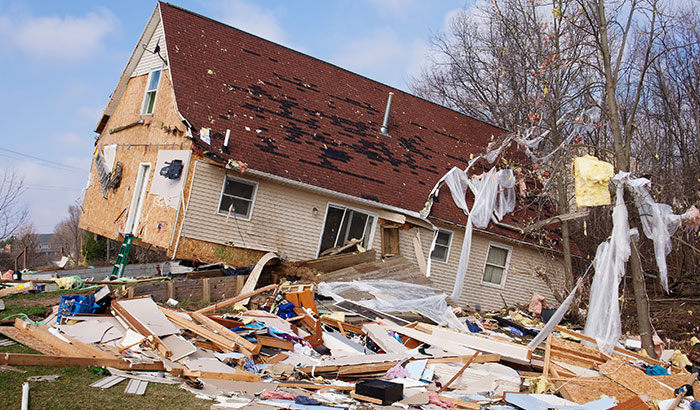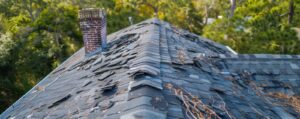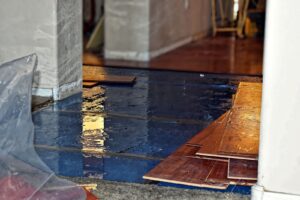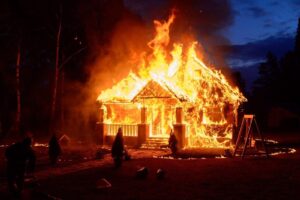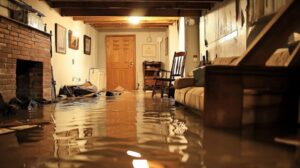Storm damage refers to damage to buildings, structures, and other property caused by severe weather events such as hurricanes, tornadoes, thunderstorms, and winter storms. Examples of damage from storms include damage to roofs, walls, windows, doors, and foundations from high winds and heavy rain or snow.
Storm damage can also include flooding, landslides, and erosion caused by heavy rain or melting snow. In addition, storm damage can be caused by lightning strikes, falling trees or branches, and hail.
It is important to note that insurance policies cover not all damage caused by storms. Therefore, it is essential to review your policy carefully to understand what is and is not covered and to document the damage as thoroughly as possible if you need to file a claim.
There are several types of storms that can cause damage to a home. Some of the most common types of storms that can cause damage include the following:
- Hurricanes – These are large tropical storms that can cause widespread hurricane house damage due to their high winds and heavy rain.
- Tornado – These are intense, cyclonic storms that can cause severe tornado damage to homes and buildings due to their high winds and flying debris.
- Thunderstorms – These storms can cause damage to homes and buildings due to strong winds, heavy rain, lightning strikes, and hail.
- Winter storms – These storms can cause damage to homes and buildings due to heavy snow, ice, and strong winds.
- Floods – Heavy rain or melting snow can cause flooding, which can lead to damage to homes and buildings.
- Windstorms – Strong winds can cause windstorm damage to roofs, windows, doors, and other parts of a home or building.
It is important to be prepared for these storms and to take steps to protect your home and property from damage. This can include installing storm shutters or reinforcing windows and doors, trimming trees and removing dead branches, and having an emergency supply kit.
There are several steps you can take to protect your home from storm damage:
- Install storm shutters or reinforce windows and doors – Storm shutters can help protect your windows from breaking during a storm, while reinforcing your windows and doors can help them withstand strong winds and flying debris.
- Trim trees and remove dead branches – Trimming trees and removing dead branches can help prevent them from falling on your home during a storm.
- Secure loose items – Make sure to secure loose items such as outdoor furniture, trash cans, and decorations, as they can become projectiles during a storm.
- Have an emergency supply kit on hand – Keep an emergency supply kit that includes non-perishable food, water, flashlights, batteries, a first aid kit, and other essential items.
- Consider installing a backup generator – A backup generator can provide power to your home if the electricity goes out during a storm.
- Know your evacuation route – Familiarize yourself with your local evacuation routes in case you need to leave your home during a storm.
- Have a plan for your pets – Make sure you have a plan in place for your pets in case you need to evacuate your home during a storm.
Cleaning any structure significantly damaged by a storm can be highly dangerous. There are many things that you should be aware of before you dive into this potentially hazardous project, such as:
- Downed power line – Storms can knock down power lines, which can be hidden by debris or not easily visible. You could be electrocuted if you come into contact with a downed power line. It’s important to stay away from any power lines and to call the appropriate authorities to report them.
- Structural damage – Storms can also cause structural damage to buildings, making them unstable or unsafe to enter. It’s important to carefully assess the safety of a structure before entering and to take appropriate precautions, such as wearing a hard hat and protective gear.
- Debris – Storms can leave behind a lot of debris, including broken glass, sharp metal, and splintered wood. This debris can cause cuts and other injuries if you’re not careful.
- Wildlife – Storms can also displace wildlife, such as snakes, rodents, and insects. Be aware of your surroundings and take precautions to avoid potential encounters with these animals.
- Flooding – If the storm causes flooding, there may be hidden hazards in the water, such as sharp objects, contaminated water, and unstable ground. It’s important to use caution when working in or near floodwater.
It is important to take safety precautions when cleaning up after a storm. This may include wearing protective gear, being aware of your surroundings, and following any safety guidelines provided by authorities or cleanup organizations. By taking these steps, you can help protect your home and property from storm damage.
However, even with these guidelines, cleaning up the damage yourself is not always a good idea. The best and safest way to ensure the job is done correctly and without injuries is to hire a professional to clean up the damage from storms.
Here are some of the main reasons why you should consider hiring a professional to clean up after your home has experienced damage from a storm:
- Safety – Cleaning up after a storm can be dangerous due to debris, damaged structures, and other hazards. A professional has the training and experience to navigate the site and remove debris safely and other hazards.
- Expertise – A professional has the knowledge and expertise to properly assess the damage and determine the best course of action for cleaning up and repairing the damage.
- Equipment – A professional has access to specialized equipment and tools that can be used to safely and efficiently clean up and repair the damage.
- Time-saving – Cleaning up after a storm can be time-consuming and labor-intensive. A professional can help save you time by quickly and efficiently completing the cleanup process.
- Insurance – Many insurance policies require a professional to clean up and repair storm damage. Hiring a professional can help ensure that your claim is processed smoothly and that the work is completed to the required standards.
Total Fire and Flood To Help With Storm Damage
By hiring a professional to clean up after your home has experienced damage from a storm, you can ensure that the job is done safely, efficiently, and to a high standard. Total Flood & Restoration has a team of experts ready to help you with your after-flood damage control. Contact us today, and let’s get cleaning.

